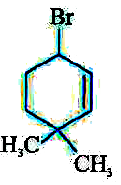2,2-dichlorobutane on boiling with aqueous KOH gives
butanal
2-butanone
2-butanol
butanoic acid
The correct Answer is:B
To solve the problem of what 2,2-dichlorobutane gives when boiled with aqueous KOH, we can follow these steps:
Step 1: Identify the Reactants
We start with 2,2-dichlorobutane, which has the following structure:
Cl|CH3−CH−CH2−CH3|Cl
Step 2: Understand the Reaction
When 2,2-dichlorobutane is boiled with aqueous KOH, it undergoes alkaline hydrolysis. This means that the chlorine atoms (Cl) will be replaced by hydroxyl groups (OH).
Step 3: Replace Chlorine with Hydroxyl Groups
The reaction will replace both chlorine atoms with hydroxyl groups, leading to the formation of 2,2-dihydroxybutane:
OH|CH3−CH−CH2−CH3|OH
Step 4: Elimination of Water
However, having two hydroxyl groups on the same carbon (the second carbon in this case) makes it unstable. Therefore, a dehydration reaction occurs where water (H2O) is eliminated from the molecule. This results in the formation of a double bond.
Step 5: Formation of the Ketone
After the elimination of water, we end up with a double bond between the second and third carbon atoms, resulting in the formation of butan-2-one (a ketone):
O∣∣CH3−C−CH2−CH3
Step 6: Naming the Product
The final product is butan-2-one, which is a ketone with four carbon atoms. The name reflects the position of the carbonyl group (C=O) on the second carbon of the butane chain.
Final Answer
When 2,2-dichlorobutane is boiled with aqueous KOH, it gives butan-2-one (a ketone).
---
We start with 2,2-dichlorobutane, which has the following structure:
When 2,2-dichlorobutane is boiled with aqueous KOH, it undergoes alkaline hydrolysis. This means that the chlorine atoms (Cl) will be replaced by hydroxyl groups (OH).
The reaction will replace both chlorine atoms with hydroxyl groups, leading to the formation of 2,2-dihydroxybutane:
However, having two hydroxyl groups on the same carbon (the second carbon in this case) makes it unstable. Therefore, a dehydration reaction occurs where water (H2O) is eliminated from the molecule. This results in the formation of a double bond.
After the elimination of water, we end up with a double bond between the second and third carbon atoms, resulting in the formation of butan-2-one (a ketone):
The final product is butan-2-one, which is a ketone with four carbon atoms. The name reflects the position of the carbonyl group (C=O) on the second carbon of the butane chain.
When 2,2-dichlorobutane is boiled with aqueous KOH, it gives butan-2-one (a ketone).
Similar Questions
Knowledge Check
- Question 1 - Select One
2,2 -dichlorobutane on boiling with queous KOH gives
AbutanalB2-butanoneC2-butanolDbutanoic acid - Question 2 - Select One
2, 2-dichloro butane on boiling with aq. Potash gives,
AbutanalB2-butanoneC2-butanolDbutanoic acid - Question 3 - Select One
2-Chloro-2-methylpropane on reaction with aqueous KOH gives X as the major product. X is
A2-ButeneB2-MethylpropeneC1-ButeneD2-Methyl-2-propanol
2-Bromo-3,3- dimethylbutane on reaction with aqueous KOH yields X as the major product. X is
View Solution1,1-dichloroethane on boiling with KOH yield
View Solution on treatment with aqueous KOHView Solution
on treatment with aqueous KOHView SolutionEthylene dichloride on treatment with aqueous KOH gives
View SolutionEthylidene chloride on treatment with aqueous KOH gives ?
View Solution
